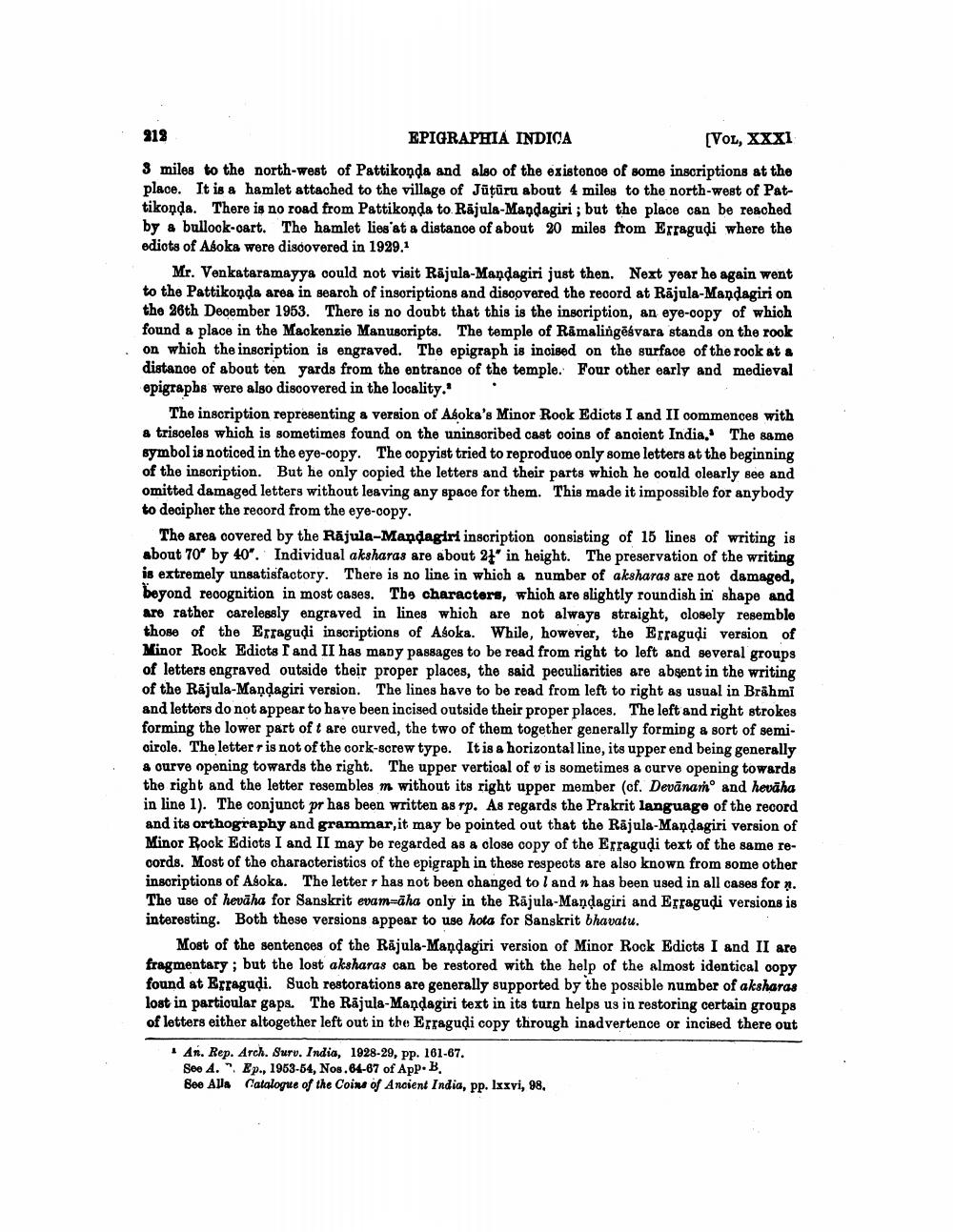________________
918 EPIGRAPHIA INDICA
(VOL, XXXI 3 miles to the north-west of Pattikonda and also of the existence of some inscriptions at the place. It is a hamlet attached to the village of Jūţūru about 4 miles to the north-west of Pattikonde. There is no road from Pattikonda to Rājula-Mandagiri ; but the place can be reached by a bullook-cart. The hamlet lies at a distance of about 20 miles from Erragudi where the ediots of Asoka were discovered in 1929.2
Mr. Venkataramayya could not visit Rājula-Maņdagiri just then. Next year he again went to the Pattikonda area in search of insoriptions and disopvered the record at Rājula-Mandagiri on the 26th December 1953. There is no doubt that this is the inscription, an eye-copy of which found a place in the Mackenzie Manuscripts. The temple of Råmalingēsvara stands on the rook on which the inscription is engraved. The epigraph is incised on the surface of the rook at a distance of about ten yards from the entrance of the temple. Four other early and medieval epigraphs were also discovered in the locality. .
The inscription representing a version of Asoka's Minor Rock Edicts I and II commences with & trisceles which is sometimes found on the uninsoribed cast ooins of ancient India. The same symbol is noticed in the eye-copy. The copyist tried to reproduce only some letters at the beginning of the inscription. But he only copied the letters and their parts which he could clearly see and omitted damaged letters without leaving any space for them. This made it impossible for anybody to decipher the record from the eye-copy.
The area covered by the Rājula-Mandagiri inscription consisting of 15 lines of writing is about 70" by 40". Individual aksharas are about 21' in height. The preservation of the writing is extremely unsatisfactory. There is no line in which a number of aksharas are not damaged, beyond recognition in most cases. The characters, which are slightly roundish in shape and are rather carelessly engraved in lines which are not always straight, closely resemble those of the Erraguļi inscriptions of Asoka. While, however, the Erragudi version of Minor Rock Ediots I and II has many passages to be read from right to left and several groups of letters engraved outside their proper places, the said peculiarities are absent in the writing of the Rājula-Mandagiri version. The lines have to be read from left to right as usual in Brāhmi and letters do not appear to have been incised outside their proper places. The left and right strokes forming the lower part of t are curved, the two of them together generally forming & sort of semigirole. The letter r is not of the cork-screw type. It is a horizontal line, its upper end being generally & ourve opening towards the right. The upper vertical of v is sometimes a curve opening towards the right and the letter resembles m without its right upper member (of. Devānam and hevāha in line 1). The conjunct pr has been written as rp. As regards the Prakrit language of the record and its orthography and grammar, it may be pointed out that the Rajula-Mandagiri version of Minor Rook Ediots I and II may be regarded as a close copy of the Erragudi text of the same reoords. Most of the characteristics of the epigraph in these respects are also known from some other insoriptions of Asoka. The letter r has not been changed to land n has been used in all cases for n. The use of heväha for Sanskrit evam-aha only in the Rajula-Mandagiri and Erragudi versions is interesting. Both these versions appear to use hota for Sanskrit bhavatu.
Most of the sentences of the Rājula-Mandagiri version of Minor Rock Edicts I and II are fragmentary ; but the lost aksharas can be restored with the help of the almost identical oopy found at Erragudi. Such restorations are generally supported by the possible number of aksharas lost in partioular gaps. The Rājula-Mandagiri text in its turn helps us in restoring certain groups of letters either altogether left out in the Erragudi copy through inadvertence or incised there out
*An. Rep. Arch. Surv. India, 1928-29, pp. 161-67.
See A. Ep., 1953-54, Nos. 64-67 of App.B. Boe ADA Catalogue of the Coins of Ancient India, pp. Ixxvi, 98,




